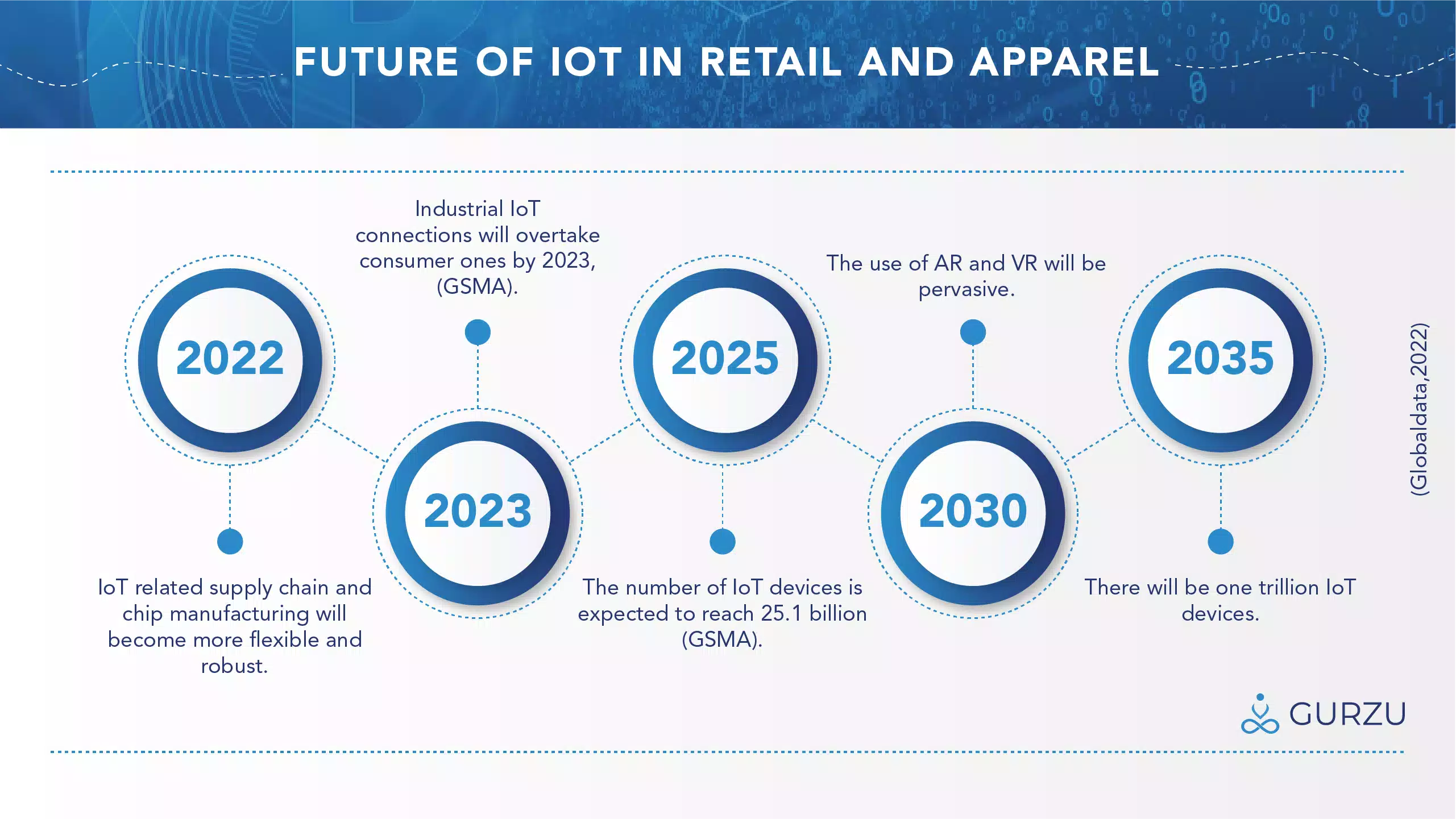We all are aware of the talks of IoT and how it is a game changer in every aspect. So will the fashion industry worth trillions get hit by the waves of IoT?
Wearables like smartwatches, google glasses are already a thing. But what is the scope of IoT-enabled fashion beyond that? Are we moving towards a future where machinery will automatically transform sketches into clothes and fabrics embedded with sensors?
According to Gartner Inc., by 2020, 50% of all consumer electronics devices will be connected to the Internet via an embedded micro-controller or a smartphone-like application. That means that everything from buildings to clothing to furnitures will be built with IoT in mind—and it will change the consumer behavior forever.
Internet of things in fashion
The Internet of things is a connection of real-life objects or “things” over the network to send and receive data and communicate with each other. These “smart” things can help automate, monitor, and track objects, resulting in better efficiency, reducing the use of resources, and deriving valuable data. The Internet of things combines the power of hardware, software, data, AI, ML, and cloud to build an ecosystem of technology. Let’s say the “Internet of things” is the Internet of the future.
Let’s see how it integrates with the fashion industry.
Imagine a designer looking to launch a new season collection. It takes months to conceptualize the collection, draw sketches, sew clothes, and showcase it in fashion shows, and more months for the final products to get into retail stores. The Internet of things can drastically reduce the time taken to go from idea to product with the use of technologies (robots?) that will help make prototypes from sketches within no time. Hence, designers (and brands) have more time to bring their vision to the market.
Fashion is not just a sensational and glamorous area, but with over 100 million tonnes of textile waste produced every year, it also might be one of the most wasteful. New technological developments (and the Internet of things, of course) aim to make fashion more sustainable, personal, and long-lasting.
The power of sensors and data
There can be multitudes of sensors helping you in pervasive ways. From environmental sensors in factories to tracking systems of assets to RFIDs in clothes, these sensors will genuinely be everywhere across the supply chain.
The natural gift of the Internet of things is the power of the data it holds. These sensors capture data every millisecond, and millions of data are gathered at the edge. The data can then be used to draw conclusions and make critical business and personal decisions.
These clothes of the future can be referred to as smart clothes. Smart clothes care for their wearers by looking after their wellness, health, fitness, and comfort. They can include detecting your posture, measuring your vitals, and tracking your activities. In the long run, the data from these sensors will be used to track your health status and might even predict if you are going to fall sick in the near future or detect the probability of you catching a chronic illness.
You might also like: How Gurzu Empowered An Australian Sustainable Fashion Startup
The tags on these clothes can give you detailed information about the clothes you wear- the fabric, the designer, how it was made, how you can style them, etc. Ultimately, you will make better decisions with this data.
Factories, warehouses, and retail spaces can use the sensors’ data to find bottlenecks in their operations, predict them, and solve them in time.
Businesses and retailers are already harnessing the power of data to create a more personal and customized shopping experience for you, their customers. With every use of online applications, businesses collect personal data from their customers. While it means a better shopping experience for you, it means more chances of sales for businesses.
Real-life Examples
Let’s think of more real-life scenarios on how the Internet of things can be of your help.
We’ve all been there: you’re at the mall and see a great shirt on someone else. You want one just like it, so you go to buy it… only to find out that they’re sold out!
It’s frustrating, right? Not only do you have to go home empty-handed, but now your style is stuck in limbo.
Let’s say you’re looking for a new pair of jeans. You could just walk into your local store and try them on, but there is no guarantee that they have exactly what you want.
Futuristic retail will have software that can help you visualize your shopping by showing you the stock in real-time, letting you virtually try on dresses, find the one that best suits you, and make virtual purchases. In fact, this is not too futuristic; our e-commerce today is running more or less on the same model. It will be more personalized and customer-focused with the help of IoT.

The Internet of things (IoT) can help solve this problem by enabling shoppers to make purchases using their phones instead of going into stores—and, more importantly, making sure those purchases are more likely to be fulfilled.
But you are mistaken if you think this stuff is too futuristic and science fiction-ish. Many manufacturers have already imagined and manufactured smart clothes integrating smart technologies.
One example is Metier Cycling which manufactures innovative cycling apparel that provides maximum efficiency to the ones wearing them. Their cycling jackets have integrated LEDs to give visibility to the racer and comfort with wind-resistant and hydrophobic fabric.
Another brilliant example is Sensoria fitness socks. Coming at a price tag of $398, these pairs include smart socks made with textile sensors. The connected app tracks your steps, speed, and distance and provides tips about your walking/running technique.
Similarly, a North Carolina state university team is developing a system called the Ethical apparel Index (EAI), which allows you to see how ethical your clothing is by scanning a QR code. It means that the power of choice is now in the hand of customers; if they don’t like how the cloth was made, they can go for better options.
Challenges
So what exactly is stopping these smart clothes from being in your wardrobe already? Indeed, you must have seen how wearables have grown in popularity these past few years.
But to manufacture a totally sensor-embedded garment, we need to find a way to make them still comfortable, valuable, and pocket-friendly. Similarly, technology needs to advance for prolonged battery life for sensors, charging, and maintenance solutions.
It is not just the sensors that need to be developed; our natural textiles and fabric also need to be customized to adapt and adjust to these technologies. However, with the biggest names in the fashion and apparel industry, like Underarmour and Levi’s, researching these new technologies, we can stay optimistic that our clothes will get truly smart within this decade.
Advantages
From what we have discussed, we can break down the advantages of the Internet of things in fashion and retail into the following points:
For Designers and Businesses
- Real-time data about customers’ preferences, buying habits, and activities are available.
- Use of AI to predict fashion trends
- Automation of production processes, reduction of time
- Improved inventory management allows retailers to know how much stock they need at any given time.
- Reduced costs by reducing waste as well as enhancing efficiency across supply chains.
- Tracking inventory and delivery processes
- Monitoring workers’ behavior to improve safety and efficiency
For Customers
- Increased access to information about trends, new products, and services
- Access to detailed information about the product they are buying, ultimately, better decision-making
- Possibility of customized services, including personalized designs
- Sustainable consumption of goods, a happy earth for all
Final Words
Fashion is not just about dressing up and showing up. For fashion enthusiasts, it’s an art of self-expression, and every piece of clothing is a vessel of storytelling. In the smaller picture, the induction of IoT and digitization might look like a fancier way of doing things, but in the bigger picture, it is imagining a better world for us all.
If you are starting or already own a fashion business, you might want to check into how you can harness the power of IoT to drive more revenue for your business.
Gurzu is a software company passionate about building powerful software that solve real-world problems. Explore some of our excellent products here! Have a tech problem you need to solve? Book a free consultation call with us.
(This article was written by Alaka on behalf of Gurzu.)

